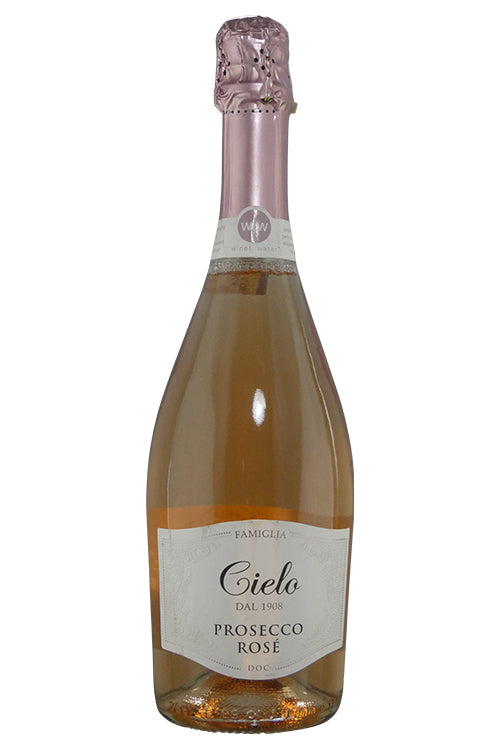1
/
of
1
Cielo Prosecco Rose - 2021 (750ml)
Cielo Prosecco Rose - 2021 (750ml)
Regular price
$14.99
Sale price
$14.99
Regular price
$19.99
Unit price
/
per
Share :

- varietal
- Region
- Sub - Region
- Type
- Reviews
A pale and light grape indigenous to northern Italy that makes one of the countries most popular sparkling wines. Most Prosecco is made in an extra extra dry, or off dry, style offering fruity aromas of confected pears and peaches. A small percentage are made in a dry Brut style offering bracing green apple and citrus fruit. Since the 2009 vintage the Prosecco zone in the Veneto region was elevated from DOC to DOCG status, joining the ranks with the likes of Barolo, Chianti and Brunello Di Montalcino. At the same time the grape was renamed from Prosecco to Glera. Now anything made outside of the region must be labeled Sparkling Glera, offering extra protection for the zone's 5,000 or so small producers. Most of the regions production (roughly three quarters) is made in a spumante or fully-sparkling style. The rest made frizzante (semi-sparkling), and a tiny amount (less than 3%) is reserved for making still wine, most of which is consumed domestically.
Along with Tuscany, Piedmont is responsible for most of Italy’s greatest wines. Here, Nebbiolo is the king of grapes with the DOCGs of Barolo and Barbaresco supplying a significant amount of the finest examples. Less expensive, but good value Nebbiolos are made within the larger Langhe DOC which Barolo and Barbaresco are both situated in. Barbera and Dolcetto are the region's other important red grapes. Moscato (Muscat) is the most popular white grape, most of which gets used in making Spumante and Frizzante (semi-sparkling) wines, notably those made in and around the town of Asti. Meanwhile, the region's most popular still white wines are made from Cortese and Arneis. Cortese are mostly made in the province of Alessandria and go by the name Gavi, while Arneis is mainly cultivated in Roero, just north west of Alba.
A town and subregion of south east Piedmont and also the name of the sparkling white wine it, along with its larger neighbouring provinces; Cuneo and Alessandria, produces. While the region makes a range of light red wines from native varieties including Barbera, Dolcetto and Gignolino to name a few, it is the Moscato Bianco (Muscat Blanc a Petits Grains) grape that is of most commercial importance. The region produces two differing styles of sparkling, Asti Spumante and Moscato d'Asti. Asti Spumante indicates a fully sparkling off dry style, which is now just referred to as Asti. The spumante was dropped out of its name when it was elevated to DOCG status in 1993 in an attempt by producers to differentiate itself from other regions who also included Spumante in the name of their sparkling wine. Moscato d'Asti is Asti's frizzante (semi-sparkling), sweeter and lower alcohol cousin, typically made with the ripest and healthiest grapes. Unlike Champagne where a second fermentation is carried out in order to make the wine sparkling, Asti and Moscato d'Asti acquires its carbonation during its one and only fermentation in stainless stell tanks. Asti is normally fermented to 7-9.5% abv Asti's and Moscato d'Astis to 5-5.5% abv. Asti's are prized for their pronounced youthful and exotic fruit forward aroma and are therefore generally non vintage, intended for drinking very young. The wines are normally served chilled in Champagne flutes and while quite high in residual sugar good examples will have enough acidity to make them compatible with a range of sweet and savoury dishes.
Sparkling wine is a wine with high levels of carbon dioxide in it making it bubble. The carbon dioxide is a result of natural fermentation, either in a bottle or a specially designed tank, or as a result of carbon dioxide injection.Sparkling wine is usually white or rosé but there are many examples of red sparkling wines. The sweetness of sparkling wine can range from very dry "brut" styles to sweeter "doux" varieties.When one thinks of sparkling wine they usually think of Champagne, but this wine is exclusively produced in the Champagne region of France and many sparkling wines are produced in other countries and regions. Most countries reserve the word Champagne for a specific type from the Champagne region of France. The French terms "Mousseux" or "Crémant" are used to refer to sparkling wine not made in the Champagne region. German and Austrian sparkling wines are called Sekt. The United States is a significant producer of sparkling wine with producers in numerous states. Recently the United Kingdom, which produced some of the earliest examples of sparkling wine, has started producing sparkling wines again.


